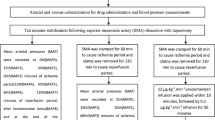Abstract
The mechanisms of gastric mucosal injury following a period of ischemia remain unclear. The aim of this study was to determine the relative contributions of ischemia, reperfusion, and reactive oxygen metabolites to mucosal injury induced by temporary occlusion of the celiac artery. Rats were subjected to 30 min of gastric ischemia in the presence of 100 mM HCl. Reperfusion periods ranged from 1 min to 24 hr. Drug treatments included allopurinol (100 mg/kg) or a combination of superoxide dismutase (15,000 units/kg), catalase (90,000 units/kg), and desferrioxamine (50 mg/kg). Mucosal injury was assessed by quantitative histology and the extent of macroscopic hemorhage. Approximately one third of the total injury to the volume of the mucosa (11.8±9.1%) was due to ischemia alone. Another third was blocked by allopurinol or superoxide dismutase, catalase, and desferrioxamine (22.1±6.9%, P<0.001; and 25.9±4.6%,P<0.01), respectively, compared with control (32.5±5.1%). In contrast, extensive surface mucosal injury (62.2 ±27.6%) occurred primarily during ischemia and was not affected by antioxidants. Macroscopic hemorrhage was halved by treatment with allopurinol (17.5±12.6%,P< 0.01) or superoxide dismutase, catalase, and desferrioxamine (15.9±14.5%,P<0.01). We conclude that temporary celiac occlusion results in gastric mucosal damage that consists of both ischemic and reperfusion components. The majority of surface mucosal injury occurred during ischemia, whereas injury to the volume of the mucosa and the vasculature occurred equally during reperfusion and was associated with reactive oxygen metabolites.
Similar content being viewed by others
References
Lucas CE, Sugawa C, Riddle J, Rector F, Rosenberg B, Walt AJ: Natural history and surgical dilemma of stress gastric bleeding. Arch Surg 102:266–273, 1971
Itoh M, Paulsen G, Guth PH: Hemorrhage shock and gastric injury. Gastroenterology 90:1103–1110, 1986
Parks DA, Granger DN: Contributions of ischemia and reperfusio to mucosal lesion formation. Am J Physiol 250:G749-G753, 1986
Perry MA, Wadhwa SS: Gradual reintroduction of oxygen reduces reperfusion injury in cat stomach. Am J Physiol 254:G366-G372, 1988
McCord JM: Oxygen-derived free radicals in postischemic tissue injury. N Engl J Med 312:159–163, 1985
Parks DA, Granger DN: Xanthine oxidase: Biochemistry and physiology. Acta Physiol Scand Suppl 548:87–99, 1986
Grisham MB, Hernandez LA, Granger DN: Xanthine oxidase and neutrophil infiltration in intestinal ischemia. Am J Physiol 251:G567-G574, 1986
Hernandez LA, Grisham MB, Twohig B, Arfors KE, Harlan JM, Granger DN: Role of neutrophils in ischemia-reperfusion-induced microvascular injury. Am J Physiol 253:H699-H703, 1987
White BC, Krause GS, Aust SD, Eyster GE: Postischemic tissue injury by iron-mediated free radical lipid peroxidation. Ann Emerg Med 14:804–809, 1985
Itoh M, Guth PH: Role of oxygen-derived free radicals in hemorrhagic shock-induced gastric lesions in the rat. Gastroenterology 88:1162–1167, 1985
Ueda S, Yoshikawa T, Takahashi S, Ichikawa H, Yasuda M, Oyamada H, Tanigawa T, Sugino S, Kondo M: Role of free radicals and lipid peroxidation in gastric mucosal injury induced by ischemia-reperfusion in rats. Scand J Gastroenterol 24:55–58, 1989
Svensson LG, Von Ritter C, Oosthuizen MMJ, Fimmel CJ, Rickards E, Hunter SJS, Robinson MF, Hinder RA: Prevention of gastric mucosal lesions following aortic crossclamping. Br J Surg 74:282–285, 1987
Lacy ER, Ito S: Microscopic analysis of ethanol damage to rat gastric mucosa after treatment of with a prostaglandin Gastroenterology 83:619–625, 1982
Smith SM, Grisham MB, Manci EA, Granger DN, Kvietys PR: Gastric mucosal injury in the rat. Role of iron and xanthine oxidase. Gastroenterology 92:950–956, 1987
Von Ritter C, Hinder RA, Oosthuizen MMJ, Svensson LG, Hunter SJS, Lambrecht H: Gastric mucosal lesions induced by hemorrhagic shock in baboons. Role of oxygen-derived free radicals. Dig Dis Sci 33:857–864, 1988
Yasue N, Guth PH: Role of exogenous acid and retransfusion in hemorrhagic shock-induced gastric lesions in the rat. Gastroenterology 94:1135–1143, 1988
O'Brien, Schultz C, Gannon B: An evaluation of the phenomenon of cytoprotection using quantitative histological criteria. J Gastroenterol Hepatol 2:113–121, 1987
Zweier JL, Kuppusamy P, Williams R, Rayburn BK, Smith D, Weisfeldt ML, Flaherty JT: Measurement and characterization of postischemic free radical generation in the isolated perfused heart. J Biol Chem 264:18890–18895, 1989
Roldan EJA, Pinus CR, Turrens JF, Boveris A: Chemilumniscence of ischemic and reperfused intestinein vivo. Gut 30:184–187, 1989
Menguy R, Desbaillets L, Masters YF: Mechanisms of stress ulcer: Influence of hypovolemic shock on energy metabolism in the gastric mucosa. Gastroenterology 66:46–55, 1974
Starlinger M, Jakesz R, Matthewa J, Yoon C, Schiessel R: The relative importance of HCO3 − and blood flow in the protection of rat gastric mucosa during shock. Gastroenterology 81:732–735, 1981
Olsson GM, Svensson I, Zdolsek JM, Brunk UT: Lysosomal enzyme leakage during the hypoxanthine/xanthine oxidase reaction. Virchow's Arch B Cell Pathol 56:385–391, 1989
Perry MA, Wadhwa S, Parks DA, Pickard W, Granger DN: Role of oxygen radicals in ischemia-induced lesions in the cat stomach. Gastroenterology 90:362–367, 1986
Zimmerman BJ, Parks DA, Grisham MB, Granger DN: Allopurinol does not enhance antioxidant properties of extracellular fluid. Am J Physiol 255:H202-H206, 1988
Gutteridge JMC, Richmond R, Halliwell B: Inhibition of the iron-catalysed formation of hydroxyl radicals from superoxide and of lipid peroxidation by desferrioxamine. Biochem J 184:469–472, 1979
Halliwell B: Superoxide, iron, vascular endothelium and reperfusion injury. Free Radic Res Commun 5:315–318, 1989
Winterbourn CC, Gutteridge JMC, Halliwell B: Doxorubican-dependent lipid peroxodation at low partial pressures of oxygen. J Free Radic Biol Med 1:43–49, 1985
Author information
Authors and Affiliations
Additional information
This study was supported by a grant from the Royal Australasian College of Surgeons.
Rights and permissions
About this article
Cite this article
Andrews, F.J., Malcontenti, C. & O'Brien, P.E. Sequence of gastric mucosal injury following ischemia and reperfusion. Digest Dis Sci 37, 1356–1361 (1992). https://doi.org/10.1007/BF01296003
Received:
Accepted:
Issue Date:
DOI: https://doi.org/10.1007/BF01296003




